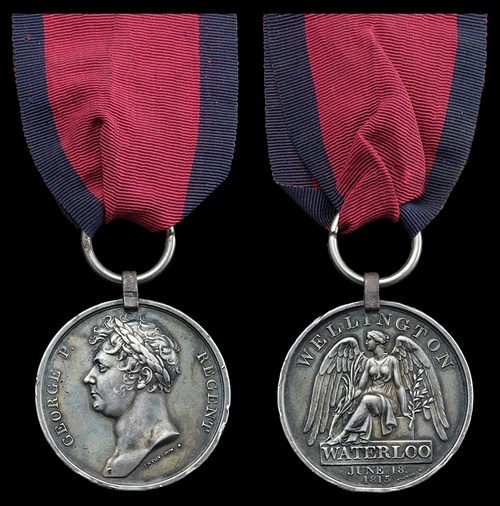
Auction: 20001 - Orders, Decorations and Medals - conducted behind closed doors
Lot: 12
Of American interest - the superb Waterloo Medal awarded to Corporal T. Chapple, 4th (King's Own) Regiment of Foot, whose long career spanned Egmont-op-Zee, Copenhagen, Corunna, Badajoz, Salamanca, Vittoria and the War of 1812; present at the Battle of Bladensburg on 24 August 1814, he shared in the Burning of Washington and the failed assault on New Orleans
At Waterloo, Chapple was severely wounded in the left foot, his Regiment playing a key role in recapturing La Haye Sainte after the repulse of the Imperial Guard
Waterloo 1815 (Corp. Thomas Chapple, 1st Batt. 4th Reg. Foot.), original steel clip and replacement split-ring suspension, original riband, minor edge bruising, toned, good very fine
Thomas Chapple was born at High Wycombe, Buckinghamshire. He enlisted into the 1st Battalion, 4th (King's Own) Regiment of Foot from the militia on 19 July 1799, aged 24. Two years earlier, the 1st Battalion's officers had been attacked by French ships while being transported from Quebec to England. They became prisoners-of-war, and the Regimental Colours were captured. The Regiment was re-trained at Barham Downs in Kent, receiving 2,700 recruits from the militia, and the King presented new Colours on 3 September 1799. Eager for revenge, the 1st Battalion sailed for the Low Countries and took part in the Battle of Alkmaar on 2 October 1799. Returning home via Ipswich, Chapple was stationed at Winchester in 1801, Dover Castle in 1802-3, and Canterbury in 1804. In 1807 he served with the 1st Battalion in the Second Battle of Copenhagen.
Promoted to Corporal during the Retreat to Corunna in 1808-9, he went on to serve at the Siege of Badajoz. When this town was stormed on 6 April 1812, the 4th were prominent in the capture of the San Vincente Bastion. This success enabled them to fall upon the rear of the enemy ramparts, assisting the other British assaults. Present at Salamanca on 22 July, Chapple went on to fight at Vittoria and the Nive, later receiving a 5-clasp Military General Service Medal (sold at Spink in 2004).
On 4 May 1814, following Napoleon's abdication, the 1st Battalion, 4th Foot joined a Royal Navy convoy at Garonne and were transported across the Atlantic, participating in Major-General Ross's victory at Bladensburg on 24 August. With just over 4,000 men, Ross defeated an American force twice that size. The battle-hardened 4th Foot managed to outflank the U.S. Marines, taking over 100 prisoners and capturing ten guns. Had it not been for this manoeuvre, the British would have suffered far higher casualties in a frontal assault. 'Bladensburg' became a regimental Battle Honour. The Americans, including President Madison, fled in panic after putting up very little resistance. This retreat, forever known as 'The Bladensburg Races', has been described by an American historian as 'the greatest disgrace ever dealt to American arms,' and 'the most humiliating episode in American history' (Howe 2006, 67).
Entering Washington, just 8 miles away, Ross and his officers enjoyed a civilised dinner in the White House before setting it aflame. Numerous other government buildings were torched in retaliation for the American damage to York in Upper Canada the previous year. A heavy storm then saved the city, and within 24 hours the British had returned to their ships. General Packenham's needless assault on New Orleans, on 8 January 1815, was rather less successful. The 4th Foot were in the front line, almost reaching the Rodriguez Canal before withering American fire forced them to withdraw. The assault took place after peace had already been concluded with the United States under the Treaty of Ghent; the news had not yet reached the combatants.
The 4th Foot were still in America when Napoleon escaped from Elba. They were rushed across the Atlantic, arriving at Ostend on 15 June 1815. After a determined 48-hour march, they arrived at Waterloo just in time to influence the battle. The 4th reinforced Wellington's beleaguered centre at 6 p.m., when La Haye Sainte had fallen and it looked as if Napoleon might clinch victory. When the Imperial Guard recoiled at 8 p.m., the 4th Foot swept forward and retook La Haye Sainte. The Allied pursuit did not stop until Paris was reached, and Chapple later received prize money for his part in capturing the French capital. To commemorate the Regiment's performance at Waterloo, a laurel wreath was added to its insignia. Chapple served throughout the campaign as a Corporal in Captain Anwyls' (No. 2) Company, 1st Battalion, 4th Foot, receiving a severe wound to the left foot at Waterloo. He remained in France for two years with the Army of Occupation, and was discharged at Deal Barracks on 7 September 1816 after 17 years and 117 days with the Colours. His Captain described him as 'a steady, brave and good soldier'; sold with copied discharge papers.
Subject to 20% VAT on Buyer’s Premium. For more information please view Terms and Conditions for Buyers.
Sold for
£3,500
Starting price
£1200




